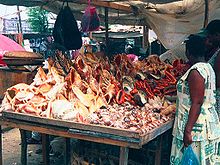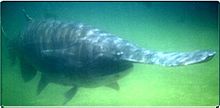Poaching: Difference between revisions
ClueBot NG (talk | contribs) m Reverting possible vandalism by 199.21.136.20 to version by 220.245.253.81. False positive? Report it. Thanks, ClueBot NG. (725382) (Bot) |
No edit summary |
||
| Line 12: | Line 12: | ||
* The right to hunt this animal is claimed by somebody. |
* The right to hunt this animal is claimed by somebody. |
||
* The type of bait is inhumane. (e.g. food unsuitable for an animal's health) |
* The type of bait is inhumane. (e.g. food unsuitable for an animal's health) |
||
* The means used are |
* The means used are legal (for example, [[bait (luring substance)|baiting]] a field while hunting [[quail]] or other animals, using [[spotlighting|spotlights]] to stun or paralyze deer, or hunting from a moving vehicle, [[watercraft]], or aircraft). |
||
* The animal or plant is protected by law or that it has been listed as extinct or endangered (see for example the [[Endangered Species Act]] for the [[USA]] or the [[Migratory Bird Treaty Act of 1918]] and similar laws/treaties. |
* The animal or plant is protected by law or that it has been listed as extinct or endangered (see for example the [[Endangered Species Act]] for the [[USA]] or the [[Migratory Bird Treaty Act of 1918]] and similar laws/treaties. |
||
* The animal or plant has been tagged by a researcher. |
* The animal or plant has been tagged by a researcher. |
||
Revision as of 15:08, 16 November 2011
| Part of a series on |
| Environmental law |
|---|
 |
| Pollution control law |
| Natural resources law |
| Reference materials |
| Related topics |
|
Poaching is the illegal taking of wild plants or animals contrary to local and international conservation and wildlife management laws. Violations of hunting laws and regulations are normally punishable by law and, collectively, such violations are known as poaching.
It may be illegal and in violation because
- The game or fish is not in season; usually the breeding season is declared as the closed season when wildlife species are protected by law.
- The poacher does not possess a valid permit.
- The poacher is illegally selling the animal, animal parts or plant for a profit.
- The animal is being hunted outside of legal hours.
- The hunter used an illegal weapon for that animal.
- The animal or plant is on restricted land.
- The right to hunt this animal is claimed by somebody.
- The type of bait is inhumane. (e.g. food unsuitable for an animal's health)
- The means used are legal (for example, baiting a field while hunting quail or other animals, using spotlights to stun or paralyze deer, or hunting from a moving vehicle, watercraft, or aircraft).
- The animal or plant is protected by law or that it has been listed as extinct or endangered (see for example the Endangered Species Act for the USA or the Migratory Bird Treaty Act of 1918 and similar laws/treaties.
- The animal or plant has been tagged by a researcher.
Note that only wild animals can be poached. Stealing or killing domestic animals is considered to be theft ("cattle rustling"), not poaching.
Plant poaching is also on the rise. A prominent example is the removal of ginseng growing in the Great Smoky Mountains National Park.[1] It is estimated that wild ginseng plants are worth more than $260–365 per pound (dried) on the black market.[2]
Traditional medicine


Traditional Chinese medicine often incorporates ingredients from all parts of plants, the leaf, stem, flower, root, and also ingredients from animals and minerals. The use of parts of endangered species (such as seahorses, rhinoceros horns, binturong and tiger bones and claws) has created controversy and resulted in a black market of poachers who hunt restricted animals.[3][4] Deep-seated cultural beliefs in the potency of tiger parts are so prevalent across Asia that laws protecting even critically endangered species such as the Sumatran tiger fail to stop the display and sale of these items in open markets, according to a 2008 report from TRAFFIC.[5] Popular "medicinal" tiger parts from poached animals include tiger penis, culturally believed to improve virility, and tiger eyes.
Slips of authority
There have been many national and international actions taken against certain kinds of poaching and hunting. Hunting for ivory was banned in 1989, but poaching of elephants continues in many parts of Africa stricken by economic decline. The Philippines has more than 400 endangered animals, all of which are illegal to poach.
Some species, such as the sturgeon or paddlefish (aka spoonbill catfish) are listed as species of "special concern" by the U.S. Federal government, but are only banned from fishing in a few states such as Mississippi and Texas.[6] The species, which is being overfished for its eggs to make caviar, is still allowed to be taken in all other states.
Addressing the problem
Some game wardens have made use of robotic decoy animals placed in high visibility areas to draw out poachers for arrest after the "animals" get shot.[7]
See also
References
- ^ "Great Smoky Mountains National Park - Threats to Wildflowers (U.S. National Park Service)". Nps.gov. 2006-07-24. Retrieved 2010-03-18.
- ^ U.S. National Park Service - Joint Undercover Operation Links International Black Market to Virginia Mountains (Published: 01-07-04)
- ^ Brian K. Weirum, Special to the Chronicle (2007-11-11). "Will traditional Chinese medicine mean the end of the wild tiger?". Sfgate.com. Retrieved 2010-03-18.
- ^ frickin retard cientist.com/channel/life/endangered-species/dn3376 "Rhino rescue plan decimates Asian antelopes". Newscientist.com. Retrieved 2010-03-18.
{{cite web}}: Check|url=value (help) - ^ Traffic.org
- ^ "News Tribune". News Tribune. 2005-11-07. Retrieved 2010-03-18.
- ^ Milwaukee Journal Sentinel - Monday, April 2, 2001
External links
- Market size of the illegal trade in animals
- Pulitzer Center on Crisis Reporting Poaching Paradise (Video)
- Black Market, produced by Mediastorm
- Hunting Laws Resource - List of official State Government ran Wildlife Websites
- EIA 25 yrs investigating the ivory trade, reports etc
- EIA (in the USA) reports etc
- The Confessions of a Poacher - 1890 Personal account of a real poacher from Project Gutenberg
